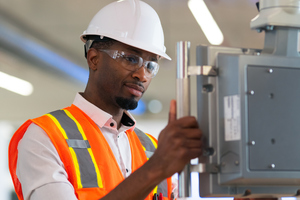
 |
Charlotte Stonestreet
Managing Editor |
| Home> | IIot & Smart Technology | >Industry 4.0 | >Seamless AI integration |
| Home> | AUTOMATION | >Systems | >Seamless AI integration |
Seamless AI integration
10 December 2024
Jordan Reynolds and Alexandra Schwertner look at how AI is revolutionising industrial automation

INCORPORATING AI into industrial processes has become essential for meeting the evolving demands of today’s customers, who seek automation systems that can learn and adapt within complex dynamic conditions. AI is not only crucial for enhancing production and quality but also for driving digital transformation, sustainability, and workforce diversity, areas of increasing importance amid the ongoing manufacturing labor shortage. Rockwell Automation is uniquely positioned to bring these autonomous capabilities to manufacturers worldwide, adapting to these evolving demands by integrating AI into the company’s existing portfolio to support customers in their digital transformation journey.
AI at every level
Integrating AI with existing systems involves incorporating artificial intelligence technologies into current IT/OT infrastructures and workflows to enhance capabilities and efficiency without disrupting ongoing operations. By integrating AI, operations can be transformed, providing more intelligent solutions and insights. However, this process demands careful planning and execution to ensure compatibility and minimise disruption. AI is integral to Rockwell Automation’s solutions, such as control systems, human-machine interfaces (HMIs), manufacturing execution systems (MES), and design environments. Collaborations with industry leaders such as Microsoft and NVIDIA are advancing AI innovation in the industrial sector.
The goal of integrating AI across these areas is to enhance operational efficiency by positioning the function closer to the process. AI agents deployed at the device or control level are designed to solve problems directly at their source, minimising latency and reducing complexity. This is not just about making systems more user-friendly; it is about refining operational precision through closed-loop control and early anomaly detection, preventing issues from escalating to subsequent stages.
When applied to generative AI in systems such as MES or design software, the focus shifts to leveraging collective knowledge. This involves capturing insights such as optimal coding practices for equipment, identifying the most probable solutions for machinery failures, or devising ideal production schedules to maximise overall equipment effectiveness (OEE). This collective intelligence empowers industries to make data-driven decisions that enhance both efficiency and reliability.
The long-term goal is to develop proprietary industrial AI models and enhance value capture from AI technologies. Leveraging our existing base of millions of data-producing devices, we gain the necessary training corpus for our models and a deployment destination.
Data everywhere
Access to data is key to successful AI deployment. Programmable Logic Controllers (PLCs) are the backbone of automated manufacturing, acting as data aggregators for sensing, thinking, and acting functions. The largest and fastest-growing data category is machine sensor data, predominantly aggregated by PLCs.
PLCs often produce more than 100 gigabytes of data annually, and there are millions of PLCs in commission on plant floors, integrating data that describes the manufacturing environment, and real-time decisions made by operators and automation systems. The data produced on an annual basis from PLCs rivals major web and social media platforms in sheer volume.
This data holds immense value, capturing the physics, behavior, and conditions of manufacturing equipment essential for producing goods. It enables us to create pre-trained models for asset condition analysis, autonomous control of complex machinery, and product quality assessment. Additionally, it supports a robust generative AI strategy for developing PLC code, engineering designs, work instructions, and more.
The industrial market's data richness is attracting attention from major players such as NVIDIA. As highlighted in Jensen Huang's GTC keynote, NVIDIA sees the industrial sector as a pivotal growth area, moving beyond consumer applications trained on social media datasets to harness machine sensor data for autonomous robots and machines.
Unique approach to utilising AI
Rather than creating separate AI or analytics categories, Rockwell Automation integrates AI across its entire portfolio, essential for major players in the food and beverage, CPG, automotive, and other industries. These manufacturers require five key elements to run production processes: design, operations, logistics, automation, and maintenance.
By embedding AI into these systems, we can address the evolving challenges and needs faced by companies using standalone AI platforms. These separate platforms often struggle with marketing, customer application, and distribution, leading to unclear value propositions and practical issues.
Most companies are creating a separate AI or analytics category, distinct from core production functions. These AI platforms, typically IIoT-based with basic analytical capabilities, stream data, train, evaluate, manage, and deploy models. However, their separation from actual production purposes creates challenges such as data latency, and the cost and complexity of pushing data to cloud-based AI solutions. They may have data and models but lack guidance on leveraging them for control enhancements or improved product quality, burdening the customer.
Additionally, distributing these capabilities through system integrators and distributors becomes problematic, as they must figure out how to integrate them into existing systems. The use cases are often improvised, and the value propositions are unclear. This disconnect results in numerous issues with these generalised platforms, complicating their practical application and effectiveness.
An AI native approach
Our approach integrates AI directly into our already-provided systems, enhancing performance and usability. By embedding AI in familiar systems such as PLCs, sensors, drives, MES, and maintenance management, we simplify AI adoption for already skilled users in these areas. Imagine design environments that automatically generate code and production line configurations, control systems that learn and adapt optimal control logic independently, and sensors that come with embedded predictive models from the start. Power devices now analyse the equipment they’re connected to, offering insights beyond their primary functions, while MES platforms autonomously recommend plans, schedules, and operational recipes tailored to evolving production demands.
Industrial engineers and operators can easily incorporate AI into their daily tasks, leveraging their existing knowledge. This seamless integration helps them derive value from AI without the steep learning curve associated with standalone platforms.
Strategically, this approach allows us to utilise our extensive installed base for data collection and AI model deployment. It ensures that AI capabilities are effectively distributed and adopted at scale, enhancing productivity and innovation in industrial environments.
Jordan Reynolds and Alexandra Schwertner are vice president, artificial intelligence and autonomy and strategic business manager at Rockwell Automation
- On-machine controller
- Medium-voltage drive tech cuts energy consumption
- Reduced lead times
- Rockwell Automation to acquire Clearpath Robotics
- Wiring & Enclosure Size Cut
- Helping adopt a centralised computing strategy
- The human + AI equation
- Graphic terminal
- Dual VPN & firewall capabilities
- Soft starter with internal bypass
- SWISSLOG SECURES MAJOR ORDER
- IMPROVED PERFORMANCE & RELIABILITY
- Engine Facility
- BULK AUTOMATION
- Integrated Packaging Solutions
- INTEGRATING ELECTRIC AND PNEUMATIC CONTROLS
- Rockwell Automation expands Midrange system portfolio
- Yokogawa joins Friends of the Supergrid
- Festo extends reach of VTUG and MPA-L valve terminals
- Siemens extends TIA Portal engineering framework




















